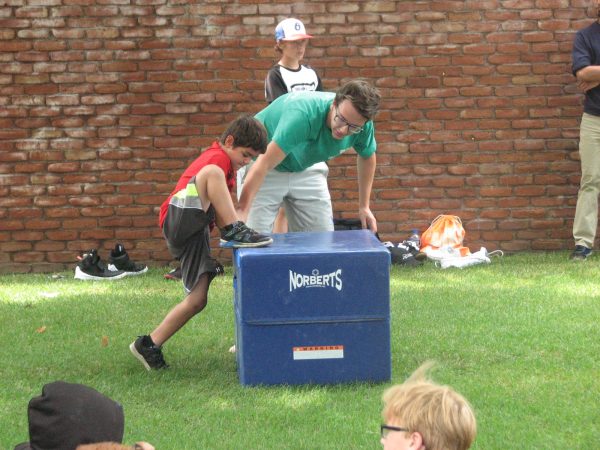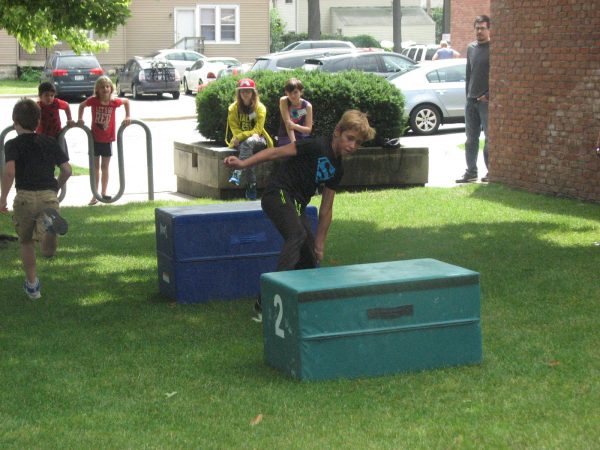2018 School Spending Survey Report
Parkour at the Library
The physical fun of parkour can bring new young patrons and valuable partnerships to a library's programming.

Courtesy of La Crosse (WI) Public Library
Now libraries are getting in on the fun. Nobody’s climbing the stacks inside, but on and around the building itself? That’s a different story. Libraries around the country are hosting programs that bring parkour to a new audience of kids and teens and provide a unique and athletic addition to your events calendar. The programs are a great opportunity to offer programming in your outdoor spaces, create new partnerships and even help patrons to look at the library in a new way.Parkour At The Library
At Ypsilanti (MI) District Library, the existing outdoor features served as a natural parkour course. Jodi Krahnke, the library’s head of youth services, noted how well the low features in the space worked for the program. “The library courtyard has a circle of large book shaped seats that were good for moving between, so they used those for youth to hop between to practice jumping,” says Krahnke. “The older building had window ledges about 3 feet off the ground, and they practiced hanging to see how that felt while still being safe. There are also low walls surrounding the building they used to work on balance. They interjected their tips about safety throughout the program instead of lecturing, which worked really well, and they kept the youth actively engaged. The entire program was about safety and healthy exercise rather than difficult stunts.” La Crosse (WI) Public Library co-hosted a parkour workshop called Parkour-Palooza with their local YMCA, which offers beginner Parkour classes. When the library was planning its summer library program, “We wanted to include a community partner offering that was active and could be held outdoors, so this collaboration seemed like a perfect fit,” says youth services manager Dawn Wacek. The chance to take advantage of the summer weather and get outside can be very popular. Wacek had 75 attendees, even though it was offered at a point of the summer when events tend to attract fewer attendees. Houston (TX) Public Library’s parkour program was also offered over the summer as a series called, “Super Moves for Superheroes.” Youth services advocate Kallie Benes says the original idea was to “teach kids how to be a Spiderman” in celebration of the anniversary of Spiderman’s first appearance in August 1962. Participants were encouraged to dress up as their favorite superhero. The library divided their program into two age groups, 6 to 12 and 13 to 17, which allowed them to open the sessions up to a wide range of participants. It was so popular, every session reached its maximum number of participants and Benes says the kids enjoyed the activities. One mother new to parkour left planning to sign them her children up for more training with the partner organization that helped run the sessions.
The chance to take advantage of the summer weather and get outside can be very popular. Wacek had 75 attendees, even though it was offered at a point of the summer when events tend to attract fewer attendees. Houston (TX) Public Library’s parkour program was also offered over the summer as a series called, “Super Moves for Superheroes.” Youth services advocate Kallie Benes says the original idea was to “teach kids how to be a Spiderman” in celebration of the anniversary of Spiderman’s first appearance in August 1962. Participants were encouraged to dress up as their favorite superhero. The library divided their program into two age groups, 6 to 12 and 13 to 17, which allowed them to open the sessions up to a wide range of participants. It was so popular, every session reached its maximum number of participants and Benes says the kids enjoyed the activities. One mother new to parkour left planning to sign them her children up for more training with the partner organization that helped run the sessions. Starting a Parkour Program
Finding a strong partner in your community is a top priority in starting a parkour program. The type of organization can range from a professional gym to local hobbyists. Bringing in skilled volunteers to lead ensures it will be safe, educational, and fun. Houston Public Library developed their successful series of classes by working closely with staff from a local gym called Urban Movement. Other libraries have also found success working with less formal groups. At the Ypsilanti District Library, Krahnke reached out to members of the parkour club at the nearby University of Michigan. She then worked with them to determine the best age range and goals for the program. “They interjected their tips about safety throughout the program instead of lecturing, which worked really well, and they kept the youth actively engaged,” says Krahnke. “The entire program was about safety and healthy exercise rather than difficult stunts.” No matter where your experts are from, they can provide expert training and guidance to the kids, as well as inspiration as they demonstrate more advanced skills for beginners to aspire to.Safety first
Given the physical nature of parkour, it is important to carefully consider steps to ensure staff and participants understand the nature of the activity and that your library is protected from liability. Some libraries already have enough protection to cover these types of workshops. In La Crosse, Wacek says, “I did have a few staff members ask if we would be leaping off of buildings. During the event, when the kids had an opportunity to try some things, I was mildly anxious that someone might overestimate their own innate skill and hurt themselves. But a former library insurance agent had previously assured me that our liability coverage was sufficient no matter what kind of program we offered.” Even if this is the case, consider what notices and forms to make part of the sign up process. When Houston Public Library prepared to offer their parkour workshop, Benes says, “the waiver was probably the biggest challenge,” because they had to make sure it met the standards of both their partner organization and the library. Once these logistics are addressed, parkour can be a great means of engaging all ages in a new way that challenges them to think, move, and play in a new way.RELATED
RECOMMENDED
CAREERS
The job outlook in 2030: Librarians will be in demand
CAREERS
The job outlook in 2030: Librarians will be in demand
ALREADY A SUBSCRIBER? LOG IN
We are currently offering this content for free. Sign up now to activate your personal profile, where you can save articles for future viewing






Add Comment :-
Be the first reader to comment.
Comment Policy:
Comment should not be empty !!!